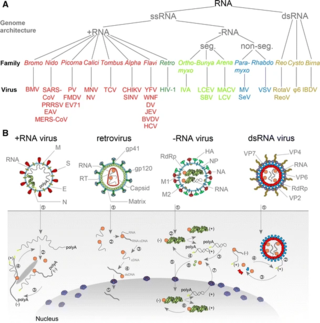
An RNA virus is a virus—other than a retrovirus—that has ribonucleic acid (RNA) as its genetic material. The nucleic acid is usually single-stranded RNA (ssRNA) but it may be double-stranded (dsRNA). Notable human diseases caused by RNA viruses include the common cold, influenza, SARS, MERS, Covid-19, Dengue Virus, hepatitis C, hepatitis E, West Nile fever, Ebola virus disease, rabies, polio, mumps, and measles.

Paramyxoviridae is a family of negative-strand RNA viruses in the order Mononegavirales. Vertebrates serve as natural hosts. Diseases associated with this family include measles, mumps, and respiratory tract infections. The family has four subfamilies, 17 genera, and 78 species, three genera of which are unassigned to a subfamily.

Morbillivirus is a genus of viruses in the order Mononegavirales, in the family Paramyxoviridae. Humans, dogs, cats, cattle, seals, and cetaceans serve as natural hosts. This genus includes seven species. Diseases in humans associated with viruses classified in this genus include measles; in animals, they include acute febrile respiratory tract infection. In 2013, a wave of increased death among the Common bottlenose dolphin population was attributed to morbillivirus.

Comovirinae is a subfamily of viruses in the order Picornavirales, in the family Secoviridae; its genera were formerly classified in the family Comoviridae. Plants serve as natural hosts. There are 62 species in this subfamily, assigned to 3 genera.

Chrysoviridae is a family of double-stranded RNA viruses. Members of the family are called chrysoviruses.

The International Committee on Taxonomy of Viruses (ICTV) authorizes and organizes the taxonomic classification of and the nomenclatures for viruses. The ICTV has developed a universal taxonomic scheme for viruses, and thus has the means to appropriately describe, name, and classify every virus that affects living organisms. The members of the International Committee on Taxonomy of Viruses are considered expert virologists. The ICTV was formed from and is governed by the Virology Division of the International Union of Microbiological Societies. Detailed work, such as delimiting the boundaries of species within a family, typically is performed by study groups of experts in the families.

Avulavirinae is a subfamily of viruses in the family Paramyxoviridae. Members of the subfamily are collectively known as avulaviruses. All members of the subfamily primarily infect birds. Avulavirinae was previously recognized as the genus Avulavirus before being elevated to a subfamily. The term avula comes from "avian rubula", distinguishing it from rubulaviruses of the subfamily Rubulavirinae due to avulaviruses only infecting birds and translating protein V from an edited RNA transcript. The most notable avulavirus is the Newcastle disease virus, a strain of Avian orthoavulavirus 1.

Rubulavirinae is a subfamily of viruses in the family Paramyxoviridae. Humans, apes, pigs, and dogs serve as natural hosts. There are currently 18 species in the two genera Orthorubulavirus and Pararubulavirus. Diseases associated with this genus include mumps. Members of the subfamily are collectively called rubulaviruses. The subfamily was previously a genus named Rubulavirus but was elevated to subfamily in 2018. Viruses of this subfamily appear to be most closely related to members of Avulavirinae.

The Herpesvirales is an order of dsDNA viruses with animal hosts, characterised by a common morphology consisting of an icosahedral capsid enclosed in a glycoprotein-containing lipid envelope. Common infections in humans caused by members of this order include cold sores, genital herpes, chickenpox, shingles, and glandular fever. Herpesvirales is the sole order in the class Herviviricetes, which is the sole class in the phylum Peploviricota.

Alphaflexiviridae is a family of viruses in the order Tymovirales. Plants and fungi serve as natural hosts. There are 65 species in this family, assigned to six genera. Diseases associated with this family include: mosaic and ringspot symptoms.

Betaflexiviridae is a family of viruses in the order Tymovirales. Plants and fungi serve as natural hosts. There are 108 species in this family, assigned to 13 genera in two subfamilies. Diseases associated with this family include mosaic and ringspot symptoms.

Secoviridae is a family of viruses in the order Picornavirales. Plants serve as natural hosts. There are 8 genera and 86 species in this family, one of which is unassigned to a genus. The family was created in 2009 with the grouping of families Sequiviridae, now dissolved, and Comoviridae, now subfamily Comovirinae, along with the then unassigned genera Cheravirus, Sadwavirus, and Torradovirus.
Proboscivirus is a genus of viruses in the order Herpesvirales, in the family Herpesviridae, in the subfamily Betaherpesvirinae. Elephants serve as natural hosts. EEHV1 is apathogenic for African elephants but causes fatal haemorrhagic disease in Asian elephants. The name "Proboscivirus" comes from the Greek word προβοσκίς or "proboscis" meaning "the elephant trunk," for which the virus accordingly uses as its means of contraction and transmission to enter the elephant's body.
Spounavirinae is a subfamily of viruses in the order Caudovirales, in the family Herelleviridae. Bacteria serve as natural hosts. There are currently five species in this subfamily, divided among 2 genera.
Aquaparamyxovirus is a genus of viruses in the family Paramyxoviridae, order Mononegavirales. The genus includes two species. Fish serve as the natural hosts for AsaPV, in which the virus may cause proliferative gill inflammation.

Parvovirinae is a subfamily of viruses in the family Parvoviridae. There are ten genera and 84 species assigned to this subfamily.
Ferlavirus, also referred to as Ophidian paramyxovirus, is a genus of viruses in the family Paramyxoviridae, order Mononegavirales. Reptiles serve as natural hosts. There is currently only one species in this genus to accommodate a single virus, Fer-de-Lance virus (FDLV).
Ackermannviridae is a family of viruses in the order Caudovirales. Gammaproteobacteria in the phylum Pseudomonadota serve as natural hosts. There are 2 subfamilies, 10 genera, and 63 species in the family.

Herelleviridae is a family of bacterial viruses of the order Caudovirales infecting members of the phylum Firmicutes. The family has five subfamilies, 33 genera and 92 species.













